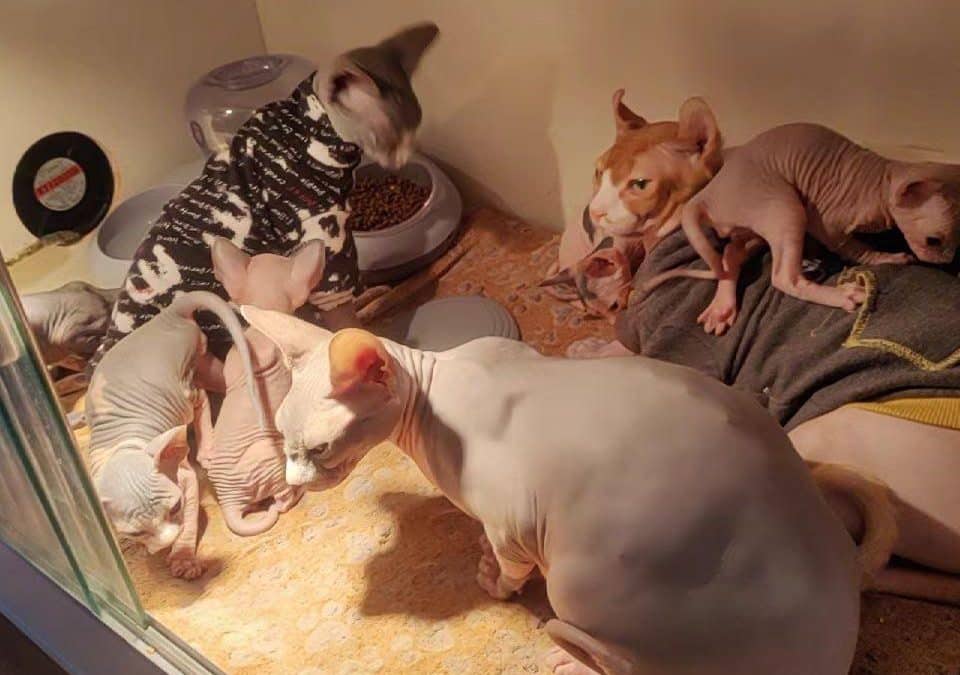
by Dr. Faith Whitehead | Nov 11, 2022 | Pet Story, Research and News
There are many reasons why cats are much loved and considered ideal house pets. One reason is that they are very independent animals. They don’t need to be taken on walks or require a lot of attention like some other pets do. Cats also have a lot of personality and are often very affectionate with their owners. They are also very clean animals and don’t require a lot of grooming. Lastly, cats are relatively low maintenance pets overall which makes them ideal for busy people. Cats have also been shown to have a calming effect on their owners, and can help reduce stress levels. A 2004 study found that 42% of cats surveyed helped their owners feel less lonely, and another study found that cat owners were 30% less likely to die of a heart attack than those who didn’t own a cat. While cats may not be the most affectionate animals, they do form strong bonds with their owners. A study in 2007 found that while cats didn’t show much preference for their owners over strangers, they did form attachments with their owners that were similar to the attachments formed between parents and their young children.
But perhaps the biggest reason people love cats is because they are so cute and lovable. They have adorable faces, and their small size means they can be easily cuddled. Cats also have a reputation for being very clean, and they groom themselves regularly. This means they don’t shed as much as other pets, and they don’t have that “wet dog” smell. First and foremost, cats are good friends for humans. Many cats are lovable. They will cuddle up and want scratches or patted on the skin. A purring cat is impossible to resist. Cats are often fairly playful when they’re not feeling affectionate. They like chasing anything hanging on a thread, including balls, feathers, and other objects. When their owners are playing along, they really like it. Cats are trainable, despite what the general public believes. Like with a dog, a cat may be educated to stop undesirable behavior or perform tricks using incentives and punishments. Even cats will fetch!
Second, cats are well-mannered members of the family. Cats don’t bark or produce other loud sounds as dogs do. The majority of cats seldom ever even meow. They often lead tranquil lives. Additionally, cats seldom have “accidents.” Most cats will utilize the litter box without fail going forward if their mothers teach them to do so. When shown the box, even stray cats often comprehend the idea and will use it frequently. Cat owners must account for the fact that their pets actually have claws. The cat will often be happy to stay off the furniture if there is a tall scratching post in a favorite cat location of the home. Cats may, of course, be declawed as a last resort.
Finally, one of the best qualities of cats as home pets is their simplicity of maintenance. Cats do not need walking. As they play and use the litter box for business, they receive enough of exercise in their home. A litter box may be easily and quickly cleaned. Cats groom themselves on their own as well. Since cats often clean themselves, it is virtually never required to bathe them. Compared to humans, cats are more fastidious about their personal hygiene. Cats are also unafraid of being left home alone for a few hours. Most cats, unlike other pets, won’t wreck the furniture if left alone. They are willing to go on as normal till their owners get back.

by Dr. Faith Whitehead | Nov 11, 2022 | Research and News, Cat Cancer & Tumors, Dog Cancer & Tumors, Food & Health, Medicines & Therapies, pet Chinese herbal medicine
Pets play an important role in TCM, where they are often used as therapy animals. In traditional TCM, there are four main categories of therapy animals: domestic animals, wild animals, insects, and reptiles. Each category has different therapeutic effects and is used for different purposes. Pets can be used to treat a wide variety of conditions, including anxiety, depression, stress, insomnia, and chronic pain. They can also be used to improve circulation, boost the immune system, and promote healing. There are a variety of ways to use pets in Chinese medicine. Common methods include acupuncture, moxibustion, cupping, and massage. Acupuncture is a form of Chinese medicine that involves inserting thin needles into the skin at specific points on the body. It is used to treat a wide variety of conditions, including pain, anxiety, nausea, and migraines. Moxibustion is a form of Chinese medicine that involves burning dried mugwort (Artemisia argyi) on or near the skin. It is used to treat a variety of conditions, including pain, inflammation, and menstrual cramps. Cupping is a form of Chinese medicine that involves placing glass cups on the skin and creating a vacuum. This vacuum pulls the skin and muscles upwards, which is said to improve circulation and relieve pain. Massage is a form of Chinese medicine that involves rubbing, kneading, or stroking the skin with the hands. It is used to treat a variety.
Domestic animals, such as dogs and cats, are the most commonly used therapy animals in China. They are often used in hospitals and nursing homes to help patients recover from illness and injury. Dogs are especially popular, as they are believed to have a special ability to sense and respond to human emotions. Therapy animals can provide companionship, emotional support, and physical contact to people who are lonely, sick, or injured. They can also help people to coping with anxiety, stress, and depression. Therapy animals can be used in a variety of settings, including hospitals, nursing homes, schools, prisons, and shelters. There is no formal training or certification required for therapy animals in China. However, animals must be healthy and have a good temperament in order to be considered for therapy work.
Wild animals, such as tigers and bears, are also used in Chinese medicine, but they are less common than domestic animals. Wild animals are thought to have more powerful therapeutic effects than domestic animals, and they are often used to treat more serious conditions. There are a number of different ways that wild animals can be used in traditional Chinese medicine. They can be used whole, or in parts, and can be consumed orally, applied topically, or injected. One of the most common ways that wild animals are used in traditional Chinese medicine is through the consumption of their body parts. This can be done by eating the meat, organs, or other tissues of the animal, or by drinking its blood. Wild animals are also sometimes used in traditional Chinese medicine through the application of their body parts to the skin. This can be done by rubbing the body part on the skin, or by applying it as a poultice. In some cases, wild animals are used in traditional Chinese medicine through injections. This is usually done with the help of acupuncture needles, which are inserted into specific points on the body. There are a number of different benefits that are associated with the use of wild animals in traditional Chinese medicine. For example, it is believed that they can help to improve circulation, reduce inflammation, and relieve pain. Wild animals are also thought to be able to improve the function of the immune system, and to help to fight off infections.
Insects, such as bees and silkworms, are also used in Chinese medicine. Insects are believed to have a range of therapeutic effects, including the ability to reduce inflammation and pain. Reptiles, such as snakes and lizards, are also used in Chinese medicine. Reptiles are thought to have powerful therapeutic effects, and they are often used to treat serious conditions. In addition to animals, Chinese medicine also uses a variety of plant-based substances. Herbs are the most commonly used plant-based substances in Chinese medicine. Chinese herbs are often used to treat a wide variety of conditions, including pain, inflammation, and digestion problems. A wide variety of plant-based substances are used in Chinese medicine, including roots, leaves, flowers, and bark.Many intractable diseases can be treated with a combination of traditional Chinese and Western medicine.
About the author: Dr. Faith Whitehead; is a licensed veterinarian and researcher.

by Dr. Faith Whitehead | Nov 11, 2022 | Pet Story, Research and News
Owning exotic creatures as personal pets is an activity that has been controversial for centuries. Some people believe that it is morally wrong to own another living creature as a personal pet, while others believe that it is an expression of our dominance over nature. There is no right or wrong answer to this question, and it is ultimately up to the individual to decide whether or not they believe it is ethical to own an exotic pet. While it is true that some people do not take proper care of their exotic pets, this does not mean that all owners are cruel or abusive. Many people who own exotic animals take excellent care of their pets and provide them with everything they need to be happy and healthy. In addition, exotic pets can pose a danger to the people and other animals around them. These animals may carry diseases that can be harmful to humans or other animals. They may also be aggressive and may attack people or other animals.
Despite exotic creatures being kept as pets, many people believe that owning exotic creatures is cruel and inhumane. These animals are often taken from their natural habitat and forced to live in captivity, where they may be subject to neglect or abuse. In addition, exotic pets may pose a danger to the people and other animals around them. There are many reasons why people choose to own exotic pets. Some people believe that these animals make unique and interesting companions. Others view exotic pets as a status symbol or a way to show off their wealth. Still, others believe that these animals provide them with a sense of security or power. Whatever the reason, it is important to remember that exotic pets are living creatures that deserve to be treated with respect. If you are considering purchasing an exotic pet, be sure to do your research and choose an animal that will be a compatible companion for you and your family.
The art of owning exotic creatures as personal pets is not archaic. There are many modern people who own and care for exotic pets and have done so for many years. Exotic pets can include reptiles, amphibians, mammals, birds, and fish. Modern day exotic pet owners often purchase their pets from breeders, pet stores, or animal sanctuaries. Exotic pet ownership can be a rewarding experience for both owner and pet. However, there are some challenges that come along with owning an exotic pet. Properly caring for an exotic pet requires knowledge and commitment. Exotic pets often have specialized care needs that can be difficult to meet. For example, some reptiles need a warm and humid environment, which can be difficult to maintain in a home. In addition, exotic pets can be expensive to purchase and care for. Exotic pets also may not be legal to own in some areas.
There are both advantages and disadvantages to owning exotic creatures as pets. Some people view exotic pets as unusual and interesting, while others may see them as dangerous or difficult to care for. Some advantages of owning an exotic pet include the potential to bond with a unique animal, the excitement of having a rare pet, and the opportunity to learn about another culture or species. Some disadvantages of owning an exotic pet include the risk of the animal escaping or injuring someone, the high cost of care, and the time and effort required to care for a pet that may have very specific needs.

by Dr. Faith Whitehead | Nov 11, 2022 | Dog Cancer & Tumors, Medicines & Therapies, Research and News
There is a great deal of ongoing research into the causes and treatment of dog cancer. Some of the most promising recent discoveries include: Firstly, a study published in the journal Carcinogenesis in March 2015 found that dogs fed a diet high in antioxidants and omega-3 fatty acids had a lower risk of developing cancer. Secondly, a study published in the journal PLoS One in January 2015 found that dogs with high levels of the enzyme lipoxygenase were more likely to develop cancer. Thirdly, a study published in the journal Nature in September 2014 found that a protein called SIRT6 protects against cancer by stopping cells from dividing. Fourthly, study published in the journal Science in June 2014 found that a drug called metformin may help to prevent cancer by slowing the growth of cancer cells. A study published in the journal Nature in May 2014 found that a protein called p53 helps to prevent cancer by stopping cells from dividing. Furthermore, a study published in the journal Nature in January 2014 found that a protein called BRCA1 helps to prevent cancer by repairing damaged DNA. A study published in the journal Science in December 2013 found that a drug called rapamycin may help to prevent cancer by slowing the growth of cancer cells. Lastly, a study published in the journal Nature in October 2013 found that a protein called PTEN helps to prevent cancer by stopping cells from dividing.
The American Kennel Club’s Canine Health Foundation is funding a study on the genetics of mast cell tumors in dogs, which will hopefully provide information on the causes and possible treatments of this type of cancer. The Canine Health Foundation is also funding a study that looks at the genetics of mast cell tumors in dogs. The hope is that this study will provide information on the causes and possible treatments of this type of cancer. These research have hypothesized the following: A possible link between certain breeds of dogs and a higher risk of developing cancer -A possible link between early spaying/neutering and a decreased risk of developing cancer. Some of the latest research on dog cancer includes studies on new treatments, such as immunotherapy and targeted therapy. Clinical trials are ongoing for many of these new treatments, so talk to your veterinarian about whether or not your dog may be a good candidate.
A study published in 2019 in the Journal of the American Veterinary Medical Association found that immunotherapy, also known as biologic therapy, was associated with a significant increase in survival time for dogs with lymphoma. The study looked at data from 2,200 dogs with lymphoma treated at 24 veterinary oncology centers. The median survival time for dogs that received immunotherapy was 386 days, compared to 172 days for dogs that did not receive immunotherapy. Another study published in 2020 in the Journal of Veterinary Internal Medicine examined the use of immunotherapy for dogs with osteosarcoma. The study found that immunotherapy increased survival time for dogs with osteosarcoma and also improved quality of life. The median survival time for dogs that received immunotherapy was 365 days, compared to 240 days for dogs that did not receive immunotherapy. Lastly, a study published in 2019 in the journal Cancer Cell looked at the use of a targeted therapy drug called toceranib phosphate (Palladia) for the treatment of dogs with mast cell tumors. The study found that toceranib phosphate was associated with a significant increase in survival time for dogs with mast cell tumors. The median survival time for dogs that received toceranib phosphate was 365 days.
Latest research indicate that a new treatment for dog cancer, called immunotherapy, is showing promising results. The treatment uses the dog’s own immune system to fight the cancer. A new drug called Palladia is showing promise as a treatment for dog cancer. Palladia targets a protein that is specific to cancer cells, and it has been shown to kill cancer cells in dogs. Palladia is currently being tested in clinical trials, and it is not yet available for general use. However, it is possible that the drug may be approved for use in the future. Palladia is not the only immunotherapy drug that is showing promise as a treatment for dog cancer. Another immunotherapy drug, called toceranib, is also being tested in clinical trials. Toceranib targets a different protein that is specific to cancer cells, and it has also been shown to kill cancer cells in dogs.
About the author: Dr. Faith Whitehead; is a licensed veterinarian and researcher.

by Dr. Faith Whitehead | Nov 11, 2022 | Medicines & Therapies, Research and News
Homeopathic veterinary medicine is a branch of alternative medicine that uses very small doses of natural substances to treat a variety of conditions in animals. Homeopathic remedies are prepared by a process of diluting and shaking the substance to create a “potentiated” solution. It can also be termed as a system of medicine that is based on the principle of “like cures like.” That is, a substance that can cause symptoms in a healthy person can be used to treat those same symptoms in an ill person. Homeopathic remedies are usually prepared by diluting a substance in water or alcohol and then administering it in very small doses. Homeopathic practitioners believe that this process helps to release the healing energy of the substance and that the body can then use this energy to heal itself.
Homeopathic veterinary medicine is used to treat animals holistically, taking into account the animal’s physical, mental, and emotional health. This approach is based on the belief that the whole animal must be treated, not just the symptoms of the disease. Homeopathic veterinary medicine is gentle, safe, and effective, and can be used to treat a wide variety of conditions. Homeopathic remedies are often very effective in treating chronic conditions that are difficult to treat with conventional medicine. Homeopathic remedies are gentle and can be used for a very long time with no side effects. Homeopathic remedies are safe for everyone, including infants, children, pregnant women, and the elderly. Homeopathic remedies are made from very small amounts of natural substances. Homeopathic remedies are prepared in a special way that makes them very potent. Homeopathic remedies are taken by mouth in pill or liquid form. The best way to find a homeopathic remedy that works for you is to consult with a trained homeopath. Homeopathic remedies are available over the counter at health food stores and online.
There is no scientific evidence to support the efficacy of homeopathic veterinary medicine in pets. The available evidence does not support the claim that homeopathic products are effective for treating any health condition in animals. Veterinary patients should be treated with conventional medicine, based on the best available scientific evidence. A 2008 systematic review of homeopathy as a treatment for any condition in humans or animals concluded that there is no reliable evidence for the efficacy of homeopathy. A 2010 review of the efficacy of homeopathy for treating health conditions in animals found limited evidence from a small number of trials that homeopathic treatments may be clinically effective for some animal health conditions. A 2012 study of homeopathic treatment of dairy cows found no clinical evidence of efficacy, and suggested that the placebo effect may have played a role in the reported positive results.
The claim that homeopathic remedies can effectively treat cats and dogs is considered false. However, some homeopathic practitioners say that their products have helped pets with various health problems. There is also anecdotal evidence that some pets have responded positively to homeopathic treatments. If you’re considering using homeopathic remedies for your pet, it’s important to consult with your veterinarian first. They can advise you on whether or not a particular remedy is likely to be effective for your pet’s condition.
About the author: Dr. Faith Whitehead; is a licensed veterinarian and researcher.

by Dr. Faith Whitehead | Nov 11, 2022 | Cat Cancer & Tumors, Dog Cancer & Tumors, Food & Health, Research and News
There are a variety of foods that are safe for dogs with cancer, as well as a few contraindications to be aware of. In general, it is best to feed your dog a diet that is high in protein and low in carbohydrates. This will help to keep their energy levels up and maintain their muscle mass. Some specific foods that are safe for dogs with cancer include: – lean meats such as chicken, turkey, and fish – cottage cheese – boiled eggs – plain yogurt – fruits and vegetables such as carrots, apples, and green beans A few things to avoid feeding your dog with cancer include: – processed foods – foods high in sugar – fatty foods – foods that contain artificial preservatives or flavors In addition to a healthy diet, there are a few supplements that can be beneficial for dogs with cancer. These include omega-3 fatty acids, vitamin E, and green tea extract. Omega-3 fatty acids help to fight inflammation, while vitamin E is an antioxidant that can help to protect cells from damage. Green tea extract contains polyphenols, which are thought to have anti-cancer properties.
Cancer is a devastating diagnosis for any pet owner, but it is especially difficult when it is your furry best friend who has been diagnosed. While there is no one-size-fits-all answer when it comes to the best diet for a dog with cancer, there are some general guidelines that can help you choose foods that will be most beneficial for your dog. The first thing to consider is whether your dog is undergoing treatment for cancer. If so, your veterinarian will likely recommend a diet that is lower in fat and higher in protein to help your dog maintain their energy levels and weight. If your dog is not undergoing treatment, you may have more flexibility in their diet, but it is still important to choose foods that will provide them with the nutrients they need.
There are many different types of cancer that can affect dogs, and each type will have different dietary requirements. For example, a dog with bone cancer may need a diet that is high in protein and calcium, while a dog with gastrointestinal cancer may need a diet that is easy to digest and low in fat. When it comes to feeding dogs with cancer, there are a few things to keep in mind. First and foremost, it’s important to work with your veterinarian to create a plan that’s best for your dog. Secondly, it’s important to be aware of potential contraindications associated with certain foods. When it comes to cancer, there are a few different types that can affect dogs. The most common types of cancer in dogs are lymphoma, mast cell tumors, and osteosarcoma. Each type of cancer comes with its own set of symptoms and treatment options, so it’s important to work with your vet to create a plan that’s right for your dog. In general, a dog with cancer will need a diet that’s high in calories and protein. This is because cancer can cause weight loss and muscle wasting. Fat is also an important part of the diet, as it provides energy and helps to absorption of fat-soluble vitamins.
About the author: Dr. Faith Whitehead; is a licensed veterinarian and researcher.






